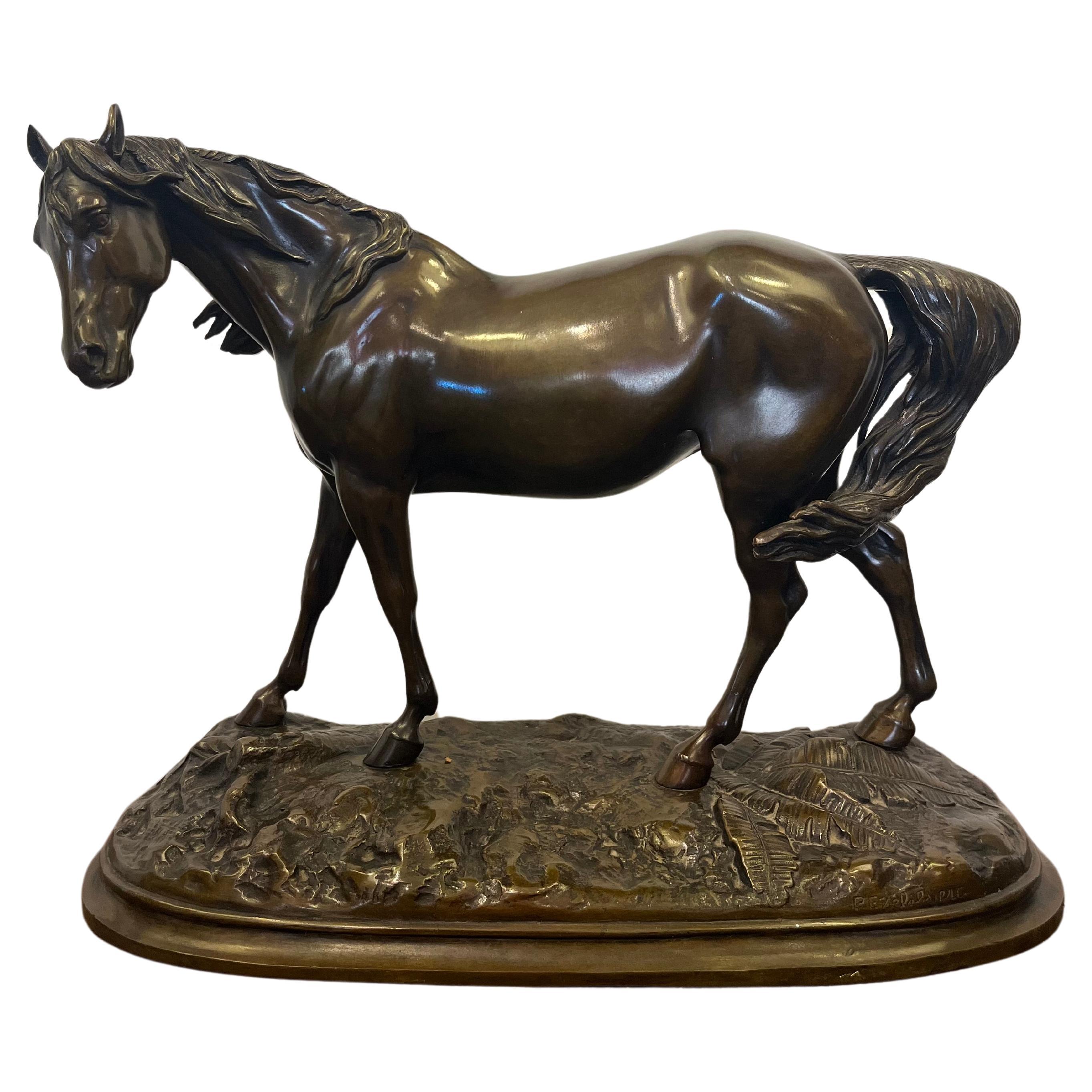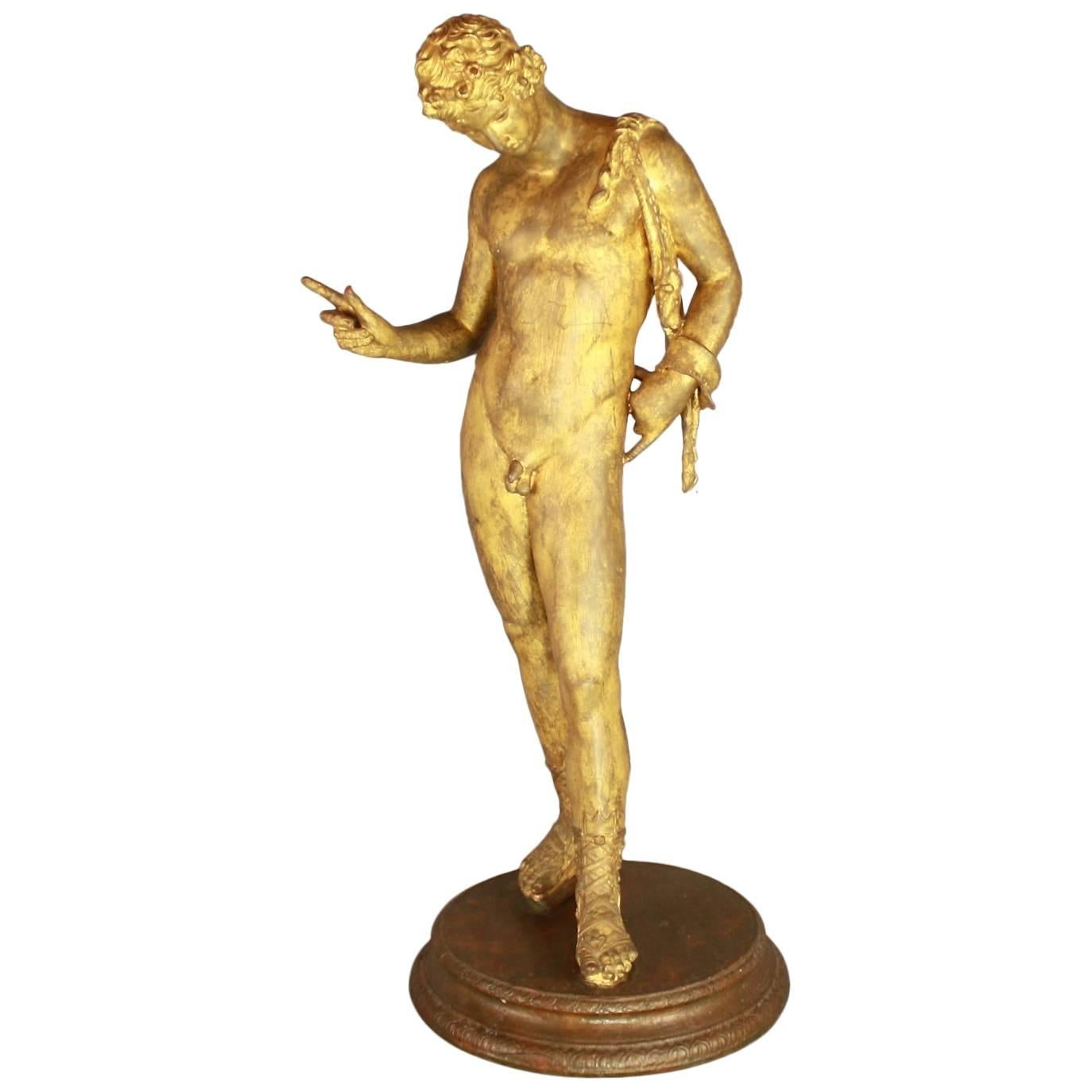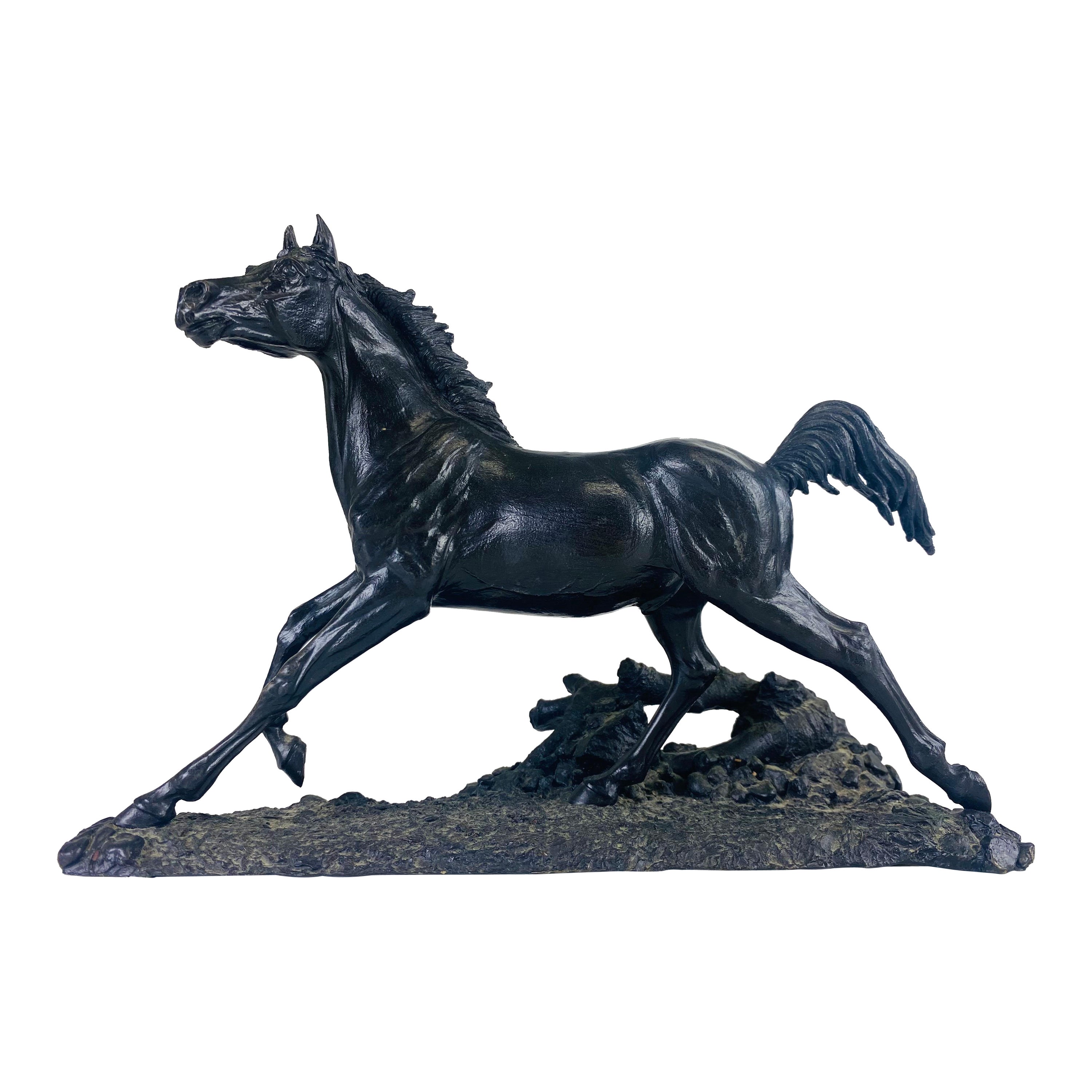Items Similar to 19th Century Gilt Bronze Horse Sculpture
Want more images or videos?
Request additional images or videos from the seller
1 of 13
19th Century Gilt Bronze Horse Sculpture
About the Item
Group of horses on a naturalistic basis
Sculpture in gilded and chiseled bronze
Period 1st part of the 19th century
France
Unsigned
Very good condition
- Dimensions:Height: 10.24 in (26.01 cm)Width: 15.75 in (40.01 cm)Depth: 5.51 in (14 cm)
- Style:Beaux Arts (Of the Period)
- Materials and Techniques:
- Place of Origin:
- Period:
- Date of Manufacture:1830
- Condition:Wear consistent with age and use.
- Seller Location:CHALON-SUR-SAÔNE, FR
- Reference Number:1stDibs: LU8593237449752
About the Seller
No Reviews Yet
Vetted Seller
These experienced sellers undergo a comprehensive evaluation by our team of in-house experts.
1stDibs seller since 2023
Typical response time: 10 hours
- ShippingRetrieving quote...Ships From: CHALON-SUR-SAÔNE, France
- Return PolicyA return for this item may be initiated within 14 days of delivery.
More From This SellerView All
- Bronze Sculpture 12th Century Soldier In Armor Late 19th CenturyLocated in CHALON-SUR-SAÔNE, FRChiseled bronze sculpture with gold and black patina. Crusades soldier in armor. The time of the Crusades is between the 1095-1291 centuries. the sculpture dates from the end of the ...Category
Antique Late 19th Century French Medieval Figurative Sculptures
MaterialsBronze
- Inkwell In Gilt Bronze And Marble 19th CenturyLocated in CHALON-SUR-SAÔNE, FRRichly chiseled and gilded bronze inkwell. Basin with lion's mouth, arched feet with scrolls and acanthus leaves, resting on an oval marble base rimmed with bronze. 19th century peri...Category
Antique Mid-19th Century French Louis XIV Inkwells
MaterialsBronze
- 19th Century Louis XVI Gilt Bronze Ram Andirons, Set of 2Located in CHALON-SUR-SAÔNE, FRPair of gilt and patinated bronze andirons. Depicting a fluted and patinated bronze firepot, supported by ram's heads and connected to the base by 4 feet with foliated hoofs. Beautif...Category
Antique Mid-19th Century European Louis XVI Andirons
MaterialsGold Plate, Bronze
- Psyche In Gilt Bronze And Carrara Marble Late 19th CenturyLocated in CHALON-SUR-SAÔNE, FRTable psyche in gilded bronze and Carrara marble. Rich ornamentation in chiseled bronze. Curved marble base. Plain white Carrara marble. Beveled mirror. Very good condition. Louis XV...Category
Antique Late 19th Century French Louis XVI Table Mirrors
MaterialsMarble, Bronze
- 19th Century Red Marble and Bronze ClockLocated in CHALON-SUR-SAÔNE, FRImportant clock in royal red marble, surmounted by a patinated bronze sculpture, a woman lying on a couch, she is dressed in antique clothes, she holds...Category
Antique 19th Century French Louis Philippe Mantel Clocks
MaterialsMarble, Bronze
- Pair of large 19th century bronze lampsLocated in CHALON-SUR-SAÔNE, FRImportant and very beautiful pair of lamps in gilded bronze with mercury and bronze with green patina. Period around 1830. Signed inside Hadrot rue des Fossés in Montmartre 14 Paris....Category
Antique 1830s French Louis Philippe Table Lamps
MaterialsBronze
You May Also Like
- Bronze Sculpture - Horse - France - 19th CenturyLocated in CANNES, FRBronze sculpture representing a moving horse Signed on the Delabrièrre terrace * Delgorge founder's stamp and lost wax France late 19th century * Édouard Delabrièrre born in Paris on...Category
Antique 19th Century French Napoleon III Animal Sculptures
MaterialsBronze
- 19th Century Gilt-Bronze Sculpture of DionysosLocated in Berlin, DEThe gilt-bronze statue of a nude youthful Dionysus standing on his right leg. In contrapposto position sculpted with a well-defined musculature. The head is bent down with a contempl...Category
Antique Late 19th Century Italian Napoleon III Figurative Sculptures
MaterialsBronze
- Antique late 19th century cast bronze horse sculpture.Located in Allentown, PAThis is an antique late 19th century cast bronze horse sculpture. This dynamic horse sculpture has an appropriate dark patina to the bronze for its age and history. The bronze horse ...Category
Antique Early 1900s American American Classical Animal Sculptures
MaterialsBronze
- Gilt and Patinated Bronze Jockey on A Horse, 19th CenturyLocated in Lisbon, PTA french "Jockey à cheval" in patinated bronze figure of a gil jockey and his faithful mount on a marble base.Category
Antique 19th Century French Napoleon III Animal Sculptures
MaterialsMarble, Bronze
- Pair French 19th/20th Century Gilt-Bronze Sculptures of The Marly Horses LampsBy Guillaume CoustouLocated in Los Angeles, CAA Fine Pair of French 19th/20th Century Gilt-Bronze Sculptures of "The Marly Horses" (Now turned into lamps) After the original by Guillaume Coustou (French, 1677-1746). The large pair of equestrian bronze sculptures, finished in a gold patina, each depicting rearing horses with their groom, both raised on oval a black slate and Bardiglio marble bases and fitted with modern electrical twin-light brass fittings and cream colored shades. The base on an ebonized wooden platform. Circa: Paris, 1900-1920. Sculpture & Base Height: 31 1/4 inches (79.8 cm) Base Width: 21 3/4 inches (55.3 cm) Base Depth: 12 3/4 inches (32.4 cm) Height to top of (Adjustable) shade fitting: 48 1/4 inches (122.6 cm) Shade Height: 15 inches (38.1 cm) Shade Width: 26 inches (66.1 cm) Shade Depth: 20 inches (50.8 cm) The original Marly Horses are two 1743–1745 Carrara marble sculpted groups by Guillaume Coustou. They were commissioned by Louis XV of France for the trough at the entrance to the grounds of his château de Marly. Coustou's last works, they were intended to replace two other sculpted groups, Mercury on Pegasus and Pegasus, Renown of Horses, both by Antoine Coysevox, which had been removed to the Tuileries Gardens in 1719. Louis XV chose the modellos in 1743 and the full-size sculptures were completed in only two years, being installed at Marly in 1745. They proved highly successful in reproduction, particularly on a smaller scale, and prefigured Théodore Géricault and other Romantic artists' obsession with equestrian subjects. The Marly horses were later also used as the central motif of the monochrome 819-line RTF/ORTF test card which was used on TF1 from 1953 until 1983. The originals were moved to the place de la Concorde in Paris in 1794 and Louis-Denis Caillouette (1790–1868) restored them in 1840. In 1984 it was concluded that the annual military parades on 14 July were damaging the sculptures and they were replaced by marble copies produced by Michel Bourbon in the studio of a subsidiary of Bouygues. The latter also gained the right to an extra copy, which was placed in Bouygues's social building. The original sculptures were moved to a former courtyard in the Richelieu wing of the Louvre Museum, which was renamed the 'cour Marly' in their honour, whilst Bourbon's two main copies were moved to the originals' first site near the trough at Marly, with work overseen by the architect Serge Macel. Guillaume Coustou the Elder (29 November 1677, Lyon – 22 February 1746, Paris) was a French sculptor of the Baroque and Louis XIV style. He was a royal sculptor for Louis XIV and Louis XV and became Director of the Royal Academy of Painting and Sculpture in 1735. He is best known for his monumental statues of horses made for the Chateau of Marly, whose replicas now stand in the Place de la Concorde in Paris. Coustou was a member of a family of famous sculptors; his uncle, Antoine Coysevox, was a royal sculptor; his elder brother, Nicolas Coustou was a sculptor, and his son Guillaume Coustou the Younger also become a noted royal sculptor. Like his older brother, he won the (Prix de Rome) of the Royal Academy which entitled him to study for four years at the French Academy in Rome. However, he refused to accept the discipline of the academy, gave up his studies, set out to make his own career as an artist. He worked for a time in the atelier of the painter Pierre Legros, and eventually returned to Paris. Upon his return to Paris, he assisted his uncle Coysevox in making two monumental equestrian sculptures, Fame and Mercury, for the Château de Marly, the new residence of Louis XIV near the Palace of Versailles, where he went to escape the crowds and ceremony of the Palace. He later (1740–1745), made his own horses, The Horses of Marly, his most famous works, to replace them. The horses reinvent the theme of the colossal Roman marbles of the Horse Tamers in the Piazza Quirinale, Rome. They were commissioned by Louis XV in 1739 and installed in 1745 at the Abreuvoir ("Horse Trough") at Marly. The horses were considered masterpieces of the grace and expressiveness of the French Late Baroque or Rococo style. After the Revolution they were moved from Marly to the beginning of the Champs-Élysées on the Place de la Concorde. The originals were brought indoors for protection at the Louvre Museum in 1984. In 1704 Coustou was received into the Académie royale de peinture et de sculpture. The work he made to mark his entrance was Hercules on the Pyre, now in the Louvre. It displays the special hallmark of the Baroque, a twisting and rising transverse pose, as well as highly skillful carving. He rose to become Director of the academy in 1733. Another of his major works from his later career, the statue of Maria Leszczynska, (1731)is on display at the Louvre. Coustou also created two colossal monuments, The Ocean and the Mediterranean among other sculptures for the park at Marly; the bronze Rhone, which formed part of the statue of Louis XIV at Lyons, and the sculptures at the entrance of the Hôtel des Invalides. Of these latter, the bas-relief representing Louis XIV mounted and accompanied by Justice and Prudence was destroyed during the Revolution, but was restored in 1815 by Pierre Cartellier from Coustou's model; the bronze figures of Mars and Minerva (1733–34), on either side of the doorway, were not interfered with. In 1714 for Marly he collaborated in two marble sculptures representing Apollo Chasing Daphne (both at the Louvre), in which Nicolas Coustou sculpted the Apollo and Guillaume the Daphne. About the same time he was commissioned to produce another running figure in marble, a Hippomenes designed to complement an Atalanta copied from the Antique by Pierre Lepautre...Category
Antique Early 1900s French Louis XV Animal Sculptures
MaterialsMarble, Bronze
- 19th Century English Gilt Bronze Dead Finch SculptureLocated in Chicago, ILThis 19th-century English life-size gilt bronze sculpture delicately captures the poignant beauty of a dead finch, meticulously crafted with intricate detail. In Victorian England, d...Category
Antique 19th Century English Animal Sculptures
MaterialsBronze
Recently Viewed
View AllMore Ways To Browse
19th Century Gilt Bronze Furnitures
Luc Art Deco Bronze
Colima Pottery
Lion Assis
Han Dynasty Camel
Murano Chicken
Chain Dog Figurines
Lion Bronze Medal
Large Bronze Statues For Garden
Antique Staffordshire Animal
Hand Carved Pig
Life Size Pair Of Dogs
Fire Breathing Dragon
Crane Figurine
Pair Large Black Ducks
Asinello Ceramica
Dog Lea Stein
Hubley Horse Door Stops





